Ryan Prenger
Upcycling Large Language Models into Mixture of Experts
Oct 10, 2024



Abstract:Upcycling pre-trained dense language models into sparse mixture-of-experts (MoE) models is an efficient approach to increase the model capacity of already trained models. However, optimal techniques for upcycling at scale remain unclear. In this work, we conduct an extensive study of upcycling methods and hyperparameters for billion-parameter scale language models. We propose a novel "virtual group" initialization scheme and weight scaling approach to enable upcycling into fine-grained MoE architectures. Through ablations, we find that upcycling outperforms continued dense model training. In addition, we show that softmax-then-topK expert routing improves over topK-then-softmax approach and higher granularity MoEs can help improve accuracy. Finally, we upcycled Nemotron-4 15B on 1T tokens and compared it to a continuously trained version of the same model on the same 1T tokens: the continuous trained model achieved 65.3% MMLU, whereas the upcycled model achieved 67.6%. Our results offer insights and best practices to effectively leverage upcycling for building MoE language models.
LeanDojo: Theorem Proving with Retrieval-Augmented Language Models
Jun 27, 2023
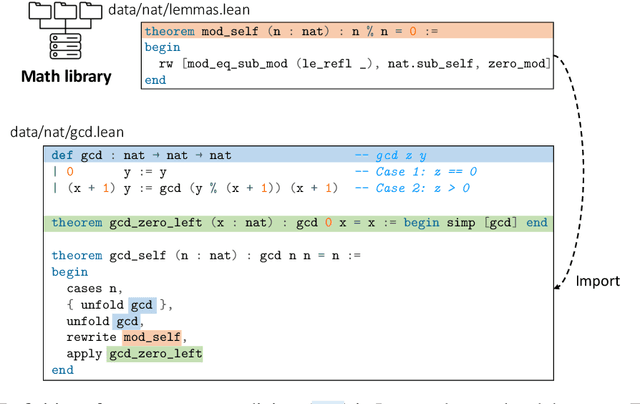
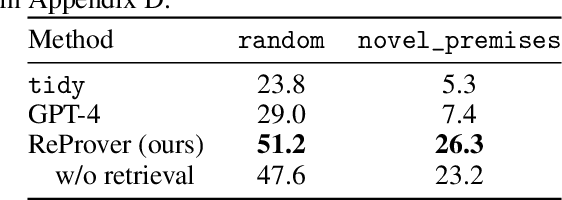
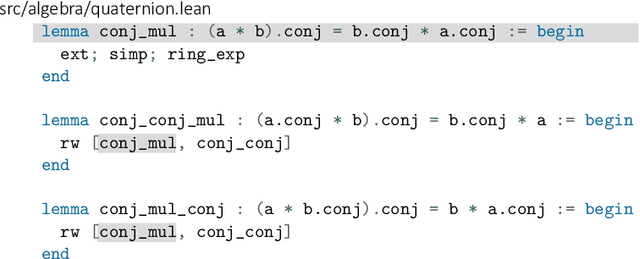
Abstract:Large language models (LLMs) have shown promise in proving formal theorems using proof assistants such as Lean. However, existing methods are difficult to reproduce or build on, due to private code, data, and large compute requirements. This has created substantial barriers to research on machine learning methods for theorem proving. This paper removes these barriers by introducing LeanDojo: an open-source Lean playground consisting of toolkits, data, models, and benchmarks. LeanDojo extracts data from Lean and enables interaction with the proof environment programmatically. It contains fine-grained annotations of premises in proofs, providing valuable data for premise selection: a key bottleneck in theorem proving. Using this data, we develop ReProver (Retrieval-Augmented Prover): the first LLM-based prover that is augmented with retrieval for selecting premises from a vast math library. It is inexpensive and needs only one GPU week of training. Our retriever leverages LeanDojo's program analysis capability to identify accessible premises and hard negative examples, which makes retrieval much more effective. Furthermore, we construct a new benchmark consisting of 96,962 theorems and proofs extracted from Lean's math library. It features challenging data split requiring the prover to generalize to theorems relying on novel premises that are never used in training. We use this benchmark for training and evaluation, and experimental results demonstrate the effectiveness of ReProver over non-retrieval baselines and GPT-4. We thus provide the first set of open-source LLM-based theorem provers without any proprietary datasets and release it under a permissive MIT license to facilitate further research.
Context Generation Improves Open Domain Question Answering
Oct 12, 2022



Abstract:Closed-book question answering (QA) requires a model to directly answer an open-domain question without access to any external knowledge. Prior work on closed-book QA either directly finetunes or prompts a pretrained language model (LM) to leverage the stored knowledge. However, they do not fully exploit the parameterized knowledge. To address this issue, we propose a two-stage, closed-book QA framework which employs a coarse-to-fine approach to extract relevant knowledge and answer a question. Our approach first generates a related context for a given question by prompting a pretrained LM. We then prompt the same LM for answer prediction using the generated context and the question. Additionally, to eliminate failure caused by context uncertainty, we marginalize over generated contexts. Experimental results on three QA benchmarks show that our method significantly outperforms previous closed-book QA methods (e.g. exact matching 68.6% vs. 55.3%), and is on par with open-book methods that exploit external knowledge sources (e.g. 68.6% vs. 68.0%). Our method is able to better exploit the stored knowledge in pretrained LMs without adding extra learnable parameters or needing finetuning, and paves the way for hybrid models that integrate pretrained LMs with external knowledge.
Multi-Stage Prompting for Knowledgeable Dialogue Generation
Mar 16, 2022



Abstract:Existing knowledge-grounded dialogue systems typically use finetuned versions of a pretrained language model (LM) and large-scale knowledge bases. These models typically fail to generalize on topics outside of the knowledge base, and require maintaining separate potentially large checkpoints each time finetuning is needed. In this paper, we aim to address these limitations by leveraging the inherent knowledge stored in the pretrained LM as well as its powerful generation ability. We propose a multi-stage prompting approach to generate knowledgeable responses from a single pretrained LM. We first prompt the LM to generate knowledge based on the dialogue context. Then, we further prompt it to generate responses based on the dialogue context and the previously generated knowledge. Results show that our knowledge generator outperforms the state-of-the-art retrieval-based model by 5.8% when combining knowledge relevance and correctness. In addition, our multi-stage prompting outperforms the finetuning-based dialogue model in terms of response knowledgeability and engagement by up to 10% and 5%, respectively. Furthermore, we scale our model up to 530 billion parameters and show that larger LMs improve the generation correctness score by up to 10%, and response relevance, knowledgeability and engagement by up to 10%. Our code is available at: https://github.com/NVIDIA/Megatron-LM.
Flowtron: an Autoregressive Flow-based Generative Network for Text-to-Speech Synthesis
May 13, 2020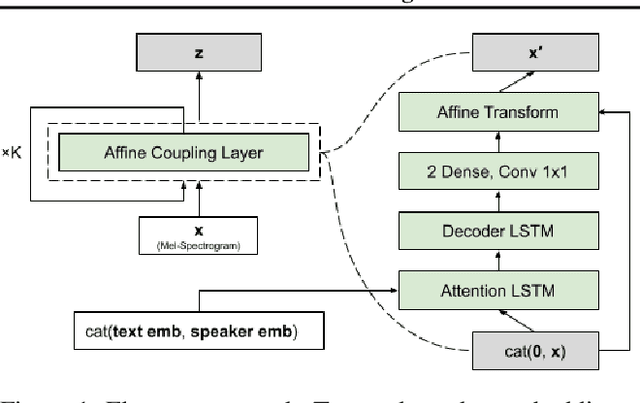

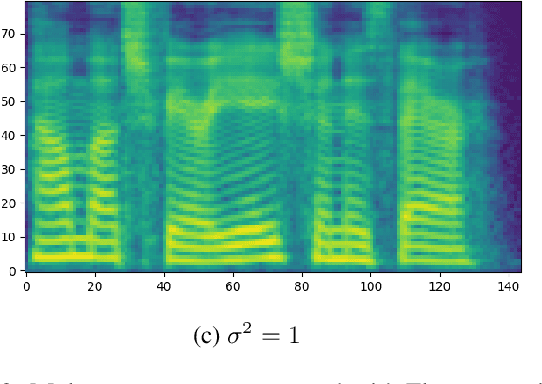
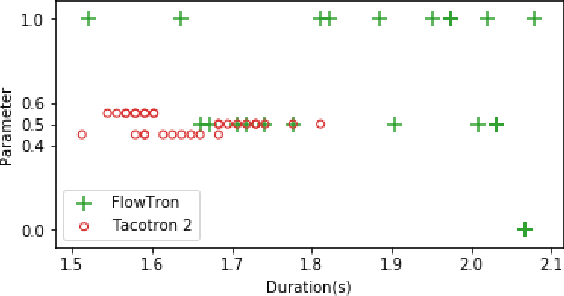
Abstract:In this paper we propose Flowtron: an autoregressive flow-based generative network for text-to-speech synthesis with control over speech variation and style transfer. Flowtron borrows insights from IAF and revamps Tacotron in order to provide high-quality and expressive mel-spectrogram synthesis. Flowtron is optimized by maximizing the likelihood of the training data, which makes training simple and stable. Flowtron learns an invertible mapping of data to a latent space that can be manipulated to control many aspects of speech synthesis (pitch, tone, speech rate, cadence, accent). Our mean opinion scores (MOS) show that Flowtron matches state-of-the-art TTS models in terms of speech quality. In addition, we provide results on control of speech variation, interpolation between samples and style transfer between speakers seen and unseen during training. Code and pre-trained models will be made publicly available at https://github.com/NVIDIA/flowtron
Mellotron: Multispeaker expressive voice synthesis by conditioning on rhythm, pitch and global style tokens
Oct 26, 2019


Abstract:Mellotron is a multispeaker voice synthesis model based on Tacotron 2 GST that can make a voice emote and sing without emotive or singing training data. By explicitly conditioning on rhythm and continuous pitch contours from an audio signal or music score, Mellotron is able to generate speech in a variety of styles ranging from read speech to expressive speech, from slow drawls to rap and from monotonous voice to singing voice. Unlike other methods, we train Mellotron using only read speech data without alignments between text and audio. We evaluate our models using the LJSpeech and LibriTTS datasets. We provide F0 Frame Errors and synthesized samples that include style transfer from other speakers, singers and styles not seen during training, procedural manipulation of rhythm and pitch and choir synthesis.
WaveGlow: A Flow-based Generative Network for Speech Synthesis
Oct 31, 2018

Abstract:In this paper we propose WaveGlow: a flow-based network capable of generating high quality speech from mel-spectrograms. WaveGlow combines insights from Glow and WaveNet in order to provide fast, efficient and high-quality audio synthesis, without the need for auto-regression. WaveGlow is implemented using only a single network, trained using only a single cost function: maximizing the likelihood of the training data, which makes the training procedure simple and stable. Our PyTorch implementation produces audio samples at a rate of more than 500 kHz on an NVIDIA V100 GPU. Mean Opinion Scores show that it delivers audio quality as good as the best publicly available WaveNet implementation. All code will be made publicly available online.
Convolutional Recurrent Neural Networks for Small-Footprint Keyword Spotting
Jul 04, 2017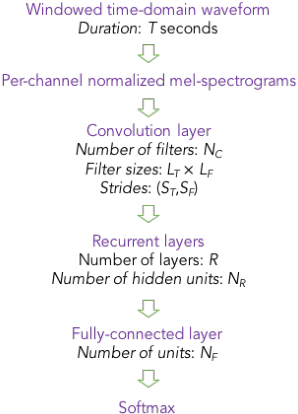

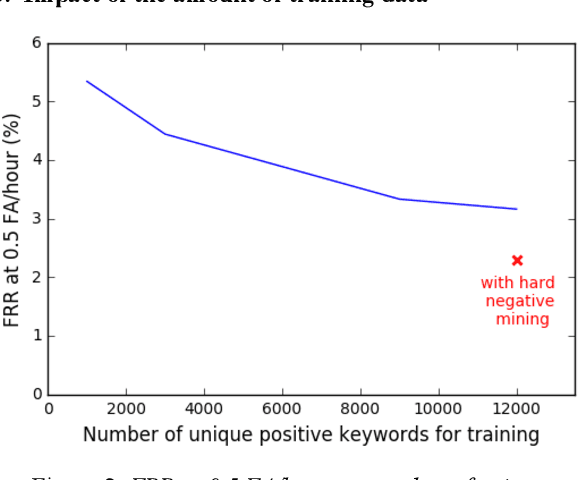

Abstract:Keyword spotting (KWS) constitutes a major component of human-technology interfaces. Maximizing the detection accuracy at a low false alarm (FA) rate, while minimizing the footprint size, latency and complexity are the goals for KWS. Towards achieving them, we study Convolutional Recurrent Neural Networks (CRNNs). Inspired by large-scale state-of-the-art speech recognition systems, we combine the strengths of convolutional layers and recurrent layers to exploit local structure and long-range context. We analyze the effect of architecture parameters, and propose training strategies to improve performance. With only ~230k parameters, our CRNN model yields acceptably low latency, and achieves 97.71% accuracy at 0.5 FA/hour for 5 dB signal-to-noise ratio.
Deep Speech 2: End-to-End Speech Recognition in English and Mandarin
Dec 08, 2015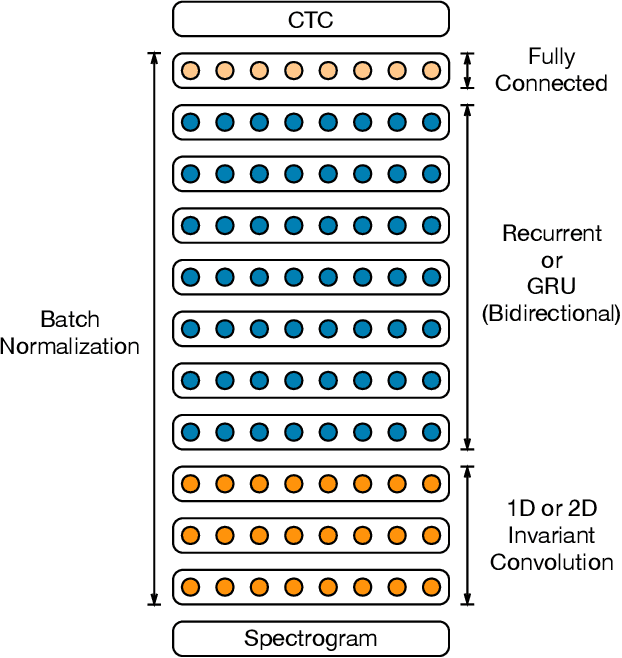

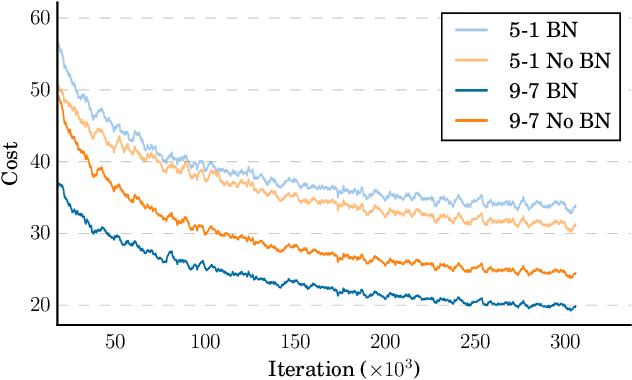

Abstract:We show that an end-to-end deep learning approach can be used to recognize either English or Mandarin Chinese speech--two vastly different languages. Because it replaces entire pipelines of hand-engineered components with neural networks, end-to-end learning allows us to handle a diverse variety of speech including noisy environments, accents and different languages. Key to our approach is our application of HPC techniques, resulting in a 7x speedup over our previous system. Because of this efficiency, experiments that previously took weeks now run in days. This enables us to iterate more quickly to identify superior architectures and algorithms. As a result, in several cases, our system is competitive with the transcription of human workers when benchmarked on standard datasets. Finally, using a technique called Batch Dispatch with GPUs in the data center, we show that our system can be inexpensively deployed in an online setting, delivering low latency when serving users at scale.
Deep Speech: Scaling up end-to-end speech recognition
Dec 19, 2014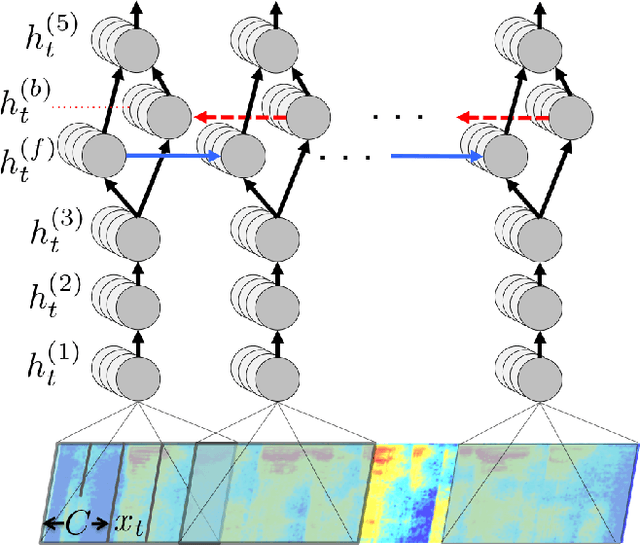

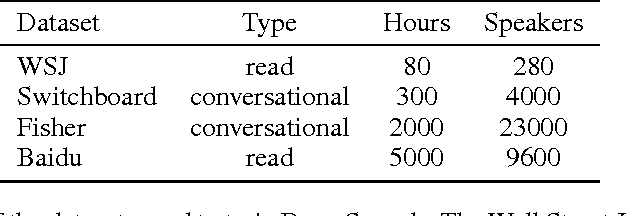
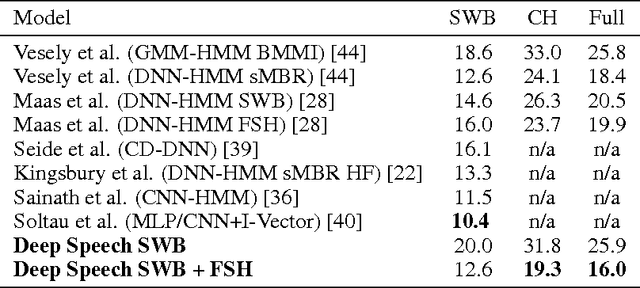
Abstract:We present a state-of-the-art speech recognition system developed using end-to-end deep learning. Our architecture is significantly simpler than traditional speech systems, which rely on laboriously engineered processing pipelines; these traditional systems also tend to perform poorly when used in noisy environments. In contrast, our system does not need hand-designed components to model background noise, reverberation, or speaker variation, but instead directly learns a function that is robust to such effects. We do not need a phoneme dictionary, nor even the concept of a "phoneme." Key to our approach is a well-optimized RNN training system that uses multiple GPUs, as well as a set of novel data synthesis techniques that allow us to efficiently obtain a large amount of varied data for training. Our system, called Deep Speech, outperforms previously published results on the widely studied Switchboard Hub5'00, achieving 16.0% error on the full test set. Deep Speech also handles challenging noisy environments better than widely used, state-of-the-art commercial speech systems.
 Add to Chrome
Add to Chrome Add to Firefox
Add to Firefox Add to Edge
Add to Edge